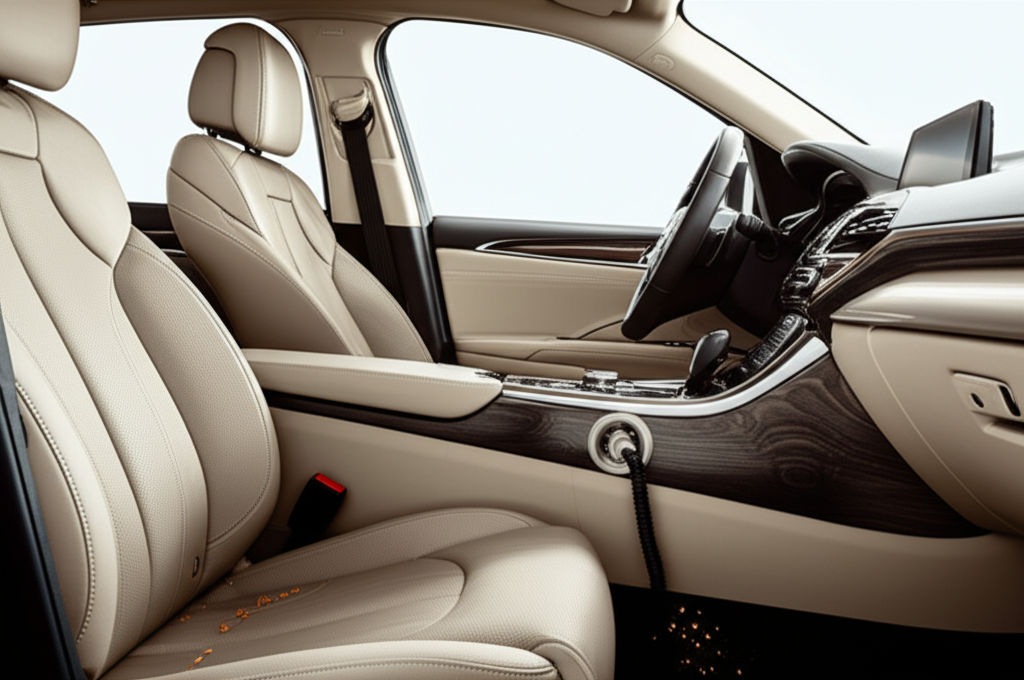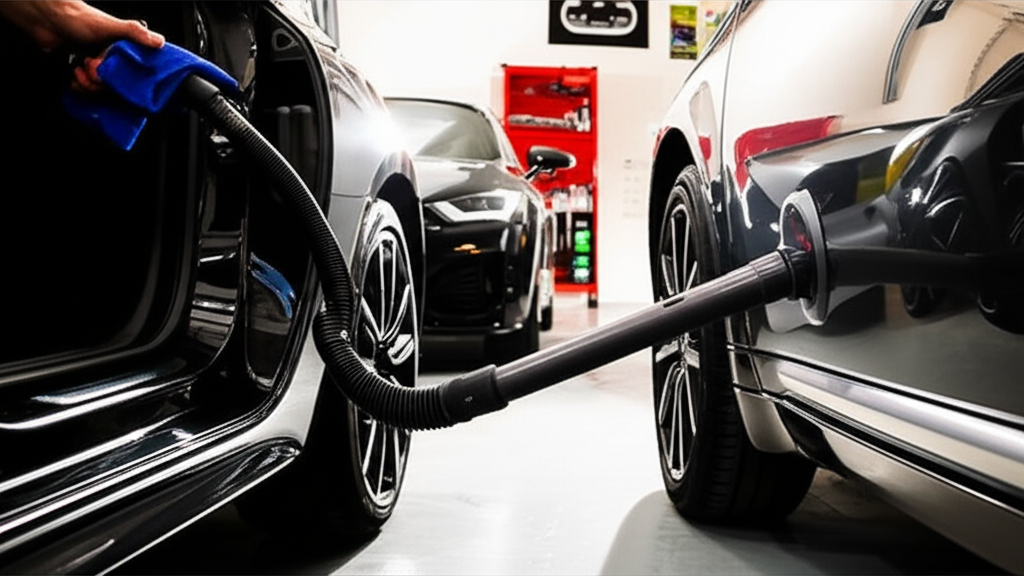- What Exactly is a Car with a Built-In Vacuum?
- How Does It Work? The Mechanics of Cleanliness
- The Unseen Benefits: Why You'll Love Your Car's Built-In Vacuum
- Unmatched Convenience
- Time-Saving Efficiency
- Consistent Interior Condition
- Cost-Effectiveness Over Time
- Environmental Friendliness (in a small way)
- Models Featuring Built-In Vacuums: Where to Find This Convenience
- How to Use Your Car's Built-In Vacuum: A Simple Step-by-Step Guide
- Step 1: Locate the System
- Step 2: Access the Hose and Attachments
- Step 3: Connect the Attachment and Power On
- Step 4: Vacuum Effectively
- Step 5: Store Everything Properly
- Step 6: Empty the Dustbin
- Maintaining Your Built-In Vacuum: Keeping It Ready to Go
- Regular Dustbin Emptying
- Check and Clean the Filter
- Inspect Hoses and Attachments
- Wipe Down Surfaces
- Pros and Cons: Is a Built-In Vacuum Right for You?
- Table: Pros and Cons of Built-In Car Vacuums
- Frequently Asked Questions About Cars with Built-In Vacuums
- Q1: How powerful is a built-in car vacuum compared to a regular vacuum cleaner?
- Q2: How often do I need to empty the dustbin?
- Q3: Can I use a built-in car vacuum for wet spills?
- Q4: What if the vacuum loses suction?
- Q5: Are these vacuums difficult to maintain?
- Q6: Do all trim levels of a model have the built-in vacuum?
- Q7: Can I add a built-in vacuum system to my car if it doesn't come with one?
- Making the Choice for a Cleaner Ride
Summary: A car with a built-in vacuum offers unmatched convenience for quick, effortless interior cleaning. It saves time and ensures your car always looks its best with minimal fuss, making those unexpected spills or everyday dust bunnies a non-issue.
The Magic Touch: Your Car With a Built-In Vacuum for Effortless Cleaning
Keeping your car’s interior tidy can feel like a constant battle. Crumbs from snacks, dust bunnies that seem to appear out of nowhere, or that mysterious dirt tracked in from your shoes can make your once-pristine car feel a bit… lived-in. Vacuuming regularly is key, but lugging out your household vacuum or dealing with flimsy portable ones can be a hassle. What if cleaning your car could be as simple as opening a compartment? That’s where a car with a built-in vacuum shines, transforming a dreaded chore into an incredibly easy task.
Imagine this: you spill coffee grounds, a child drops a cracker, or you notice a layer of dust on your dashboard. Instead of sighing and planning a trip to the car wash or digging for your portable vacuum, you simply open a small door, pull out a hose, and vacuum it up in seconds. Sound too good to be true? It’s not! Many vehicles now come equipped with integrated vacuum systems, making interior maintenance incredibly convenient. This guide will walk you through everything you need to know about this fantastic feature, how it works, and why it might be the essential upgrade you never knew you needed for effortless car cleaning.
What Exactly is a Car with a Built-In Vacuum?

Think of it as a dedicated, permanently installed vacuum cleaner specifically designed for your car. These systems aren’t just a loose handheld vacuum stored in the trunk. Instead, they are integrated right into the vehicle’s design, often featuring a powerful motor, a dustbin, and a flexible hose with various attachments, all neatly tucked away when not in use. They are about making cleaning accessible and quick for everyday messes.
How Does It Work? The Mechanics of Cleanliness
The concept is simple, yet the engineering is impressive. A built-in car vacuum system typically comprises a few key components:
Central Vacuum Unit: This is the heart of the system, usually a compact but powerful motor and a dust container that efficiently collects dirt and debris. Its location varies – it might be in the cargo area, under a seat, or integrated into a panel.
Hose and Attachments: A flexible hose, often housed within a wall or compartment, can be easily extended. It connects to a set of specialized attachments designed for car interiors, like crevice tools for tight spots, upholstery brushes for seats, and dusting brushes for delicate surfaces.
Power Source: The system draws power directly from the car’s electrical system, ensuring it’s ready to go whenever you need it.
When you need to clean, you simply extend the hose, attach the appropriate tool, and power up the unit. The vacuum sucks up dirt, dust, and small debris, depositing it into the onboard dustbin. Once you’re done, you retract the hose, empty the dustbin (usually a straightforward process), and stow everything away, leaving your car looking neat and tidy without any external equipment.
The Unseen Benefits: Why You’ll Love Your Car’s Built-In Vacuum
Having a vacuum right there in your car isn’t just a novelty; it offers practical advantages that can significantly improve your driving experience and the condition of your vehicle.
Unmatched Convenience
This is the primary selling point. No more planning a cleaning session or making a special trip. Spilled snacks on the way home from a soccer game? A quick cleanup is possible before you even get out of the car. Dust accumulating on your dashboard? A few seconds with the vacuum makes it disappear. This instant accessibility means minor messes never have the chance to become major ones.
Time-Saving Efficiency
Think about how long it takes to get out your portable vacuum, plug it in, find the right attachments, vacuum, empty it, and then put it all away. With a built-in system, the hose is ready, the attachments are likely nearby, and the power is always on. You can often complete a spot clean in a fraction of the time.
Consistent Interior Condition
Because cleaning is so easy, you’re more likely to do it regularly. This consistent maintenance prevents dirt and grime from settling into upholstery and carpets, preserving the interior’s appearance and potentially its resale value. A well-maintained interior just feels better to be in.
Cost-Effectiveness Over Time
While a car with a built-in vacuum might have a slightly higher initial cost, consider the money saved on professional detailing services or the purchase of multiple portable vacuums. The convenience and integrated nature mean you use it more, reducing the need for expensive external cleaning solutions.
Environmental Friendliness (in a small way)
By making it easier to clean your car yourself, you might reduce your reliance on disposable wipes or frequent trips to water-guzzling car washes for minor interior cleanup.
Models Featuring Built-In Vacuums: Where to Find This Convenience
Historically, built-in vacuums were often found in luxury vehicles or offered as a premium option on minivans and SUVs. However, this feature is becoming more accessible. Brands known for incorporating thoughtful amenities often include vehicles with integrated vacuums.
Some notable examples from the past and even some current models that have featured or continue to feature this amenity include:
Dodge Grand Caravan: Famously integrated Stow ‘n Vac systems in certain trim levels, making it a popular choice for families who needed quick cleanups on the go.
Chrysler Pacifica: The successor to the Grand Caravan, the Pacifica has also offered integrated vacuum features, continuing the tradition of family-friendly convenience.
Some Ford SUVs and Trucks: Certain higher trim levels have, at times, offered integrated vacuum systems as an option for enhanced utility.
* Luxury Brands: You might find integrated vacuums as a feature in some higher-end sedans and SUVs from brands like Audi, Mercedes-Benz, or BMW, often as part of a premium package.
It’s important to note that specific features can vary significantly by model year and trim level. If you’re looking at a specific vehicle, always check the specifications or ask the dealer about the presence and functionality of a built-in vacuum system. Automotive technology evolves rapidly, and what was once a niche feature is becoming more common, driven by consumer demand for convenience.
How to Use Your Car’s Built-In Vacuum: A Simple Step-by-Step Guide
Operating a built-in vacuum is designed to be intuitive, but a quick guide ensures you get the most out of it and make it a seamless part of your car care routine.
Step 1: Locate the System
First, find where your car’s vacuum system is stored. This is typically in the trunk or cargo area, often behind a small access panel or door. It might be labeled “Vacuum” or have an icon indicating its function. Some systems have the hose stored in a reel or a compartment along the side of the cargo area.
Step 2: Access the Hose and Attachments
Open the compartment. You should see the vacuum hose, usually coiled or neatly stored. Pull the hose out. Most systems will have a collection of attachments stored nearby or attached to the hose itself. Familiarize yourself with these tools: a crevice tool for tight spaces (like between seats or in door pockets), an upholstery brush for seats and floor mats, and a general dusting brush for dashboards and vents.
Step 3: Connect the Attachment and Power On
Choose the appropriate attachment for the area you want to clean and connect it firmly to the end of the hose. Then, locate the power button for the vacuum unit. This might be on the unit itself, on the hose handle, or sometimes integrated into the car’s infotainment system or a dedicated button on the dashboard or center console.
Step 4: Vacuum Effectively
Start cleaning! Work methodically, moving from top to bottom so any dust you dislodge falls onto areas you haven’t cleaned yet. Use the crevice tool for those hard-to-reach spots, the upholstery brush for seats and carpets, and the dusting brush for delicate surfaces. Don’t forget your door pockets, the center console, and under the seats – these are common crumb collection zones.
Step 5: Store Everything Properly
Once you’re finished, turn off the vacuum. Disconnect the attachment. Carefully retract the hose into its storage compartment. Ensure it’s coiled neatly or stored as designed to prevent damage. Re-attach any accessories that came loose.
Step 6: Empty the Dustbin
This is a crucial step for maintaining suction power. Locate the dustbin. It usually has a latch or clips that allow you to easily remove it. Take the dustbin outside your car (to avoid putting dust back into the cabin) and empty it into a trash can. Many dustbins are washable; check your owner’s manual for specific instructions.
Maintaining Your Built-In Vacuum: Keeping It Ready to Go
Just like any appliance, your car’s built-in vacuum needs a little care to perform its best. Regular maintenance ensures it’s always ready to tackle those unexpected messes.
Regular Dustbin Emptying
This is the most important maintenance task. A full dustbin severely reduces suction power and can cause the motor to overheat. Make it a habit to empty the dustbin after each use, or at least every few uses, especially if you’ve vacuumed up a significant amount of debris.
Check and Clean the Filter
Most vacuum systems have an internal filter to prevent dust from reaching the motor. This filter can become clogged over time. Refer to your owner’s manual for its location and cleaning instructions. Some filters are washable, while others may need to be replaced periodically. A clean filter ensures optimal airflow and suction.
Inspect Hoses and Attachments
Occasionally, check the vacuum hose for any cracks, tears, or blockages. Ensure the attachments are not cracked or damaged. Clear any debris that might be stuck inside the hose or attachments. A smooth airflow is key to good performance.
Wipe Down Surfaces
The exterior of the vacuum unit, hose storage, and the car’s interior surfaces where the vacuum is stored can accumulate dust. A quick wipe-down with a damp cloth will keep everything looking clean and prevent further dust build-up.
Pros and Cons: Is a Built-In Vacuum Right for You?
Like any feature, a car with a built-in vacuum has its advantages and disadvantages. Weighing these can help you decide if it’s a priority for your next vehicle.
Table: Pros and Cons of Built-In Car Vacuums
| Pros | Cons |
|---|---|
| Unparalleled convenience for quick cleanups. | Can add to the initial purchase price of the vehicle. |
| Saves time and effort compared to portable vacuums. | May offer less powerful suction than high-end household vacuums. |
| Encourages regular interior maintenance. | Dustbin capacity might be smaller, requiring frequent emptying. |
| Integrated and neatly stored, doesn’t take up extra space. | Repair or replacement of the integrated system can be costly if issues arise. |
| Potentially increases resale value for families or frequent travelers. | May require specific knowledge from your owner’s manual for maintenance. |
| Always available when you need it, no setup required. | Not typically available on all makes and models, limiting options. |
Frequently Asked Questions About Cars with Built-In Vacuums
Here are answers to some common questions beginner DIYers and car owners might have about these convenient cleaning systems.
Q1: How powerful is a built-in car vacuum compared to a regular vacuum cleaner?
Built-in car vacuums are designed for convenience and quick cleanups of everyday dirt, crumbs, and dust. While they are significantly more powerful than most handheld portable vacuums, they generally don’t match the suction power of full-sized household vacuums. However, for keeping your car’s interior consistently tidy between deep cleans, they are more than adequate.
Q2: How often do I need to empty the dustbin?
This depends on how often you use the vacuum and how much debris you pick up. For light dusting and small crumbs, you might empty it every few uses. If you’re cleaning up after a significant spill (like sand or a bag of snacks), you should empty it immediately. Regularly emptying prevents loss of suction and keeps the system running efficiently.
Q3: Can I use a built-in car vacuum for wet spills?
Generally, no. Most built-in car vacuum systems are designed for dry debris only. Using them for wet spills can damage the motor and create a fire hazard. Always check your owner’s manual. For wet messes, it’s best to use absorbent cloths or specialized car wet/dry vacuums.
Q4: What if the vacuum loses suction?
The most common reason for lost suction is a full dustbin or a clogged filter. First, empty the dustbin. If that doesn’t help, locate and clean or replace the filter according to your owner’s manual. Also, check the hose and attachments for any blockages.
Q5: Are these vacuums difficult to maintain?
No, maintaining a built-in car vacuum is usually quite simple. The primary task is regularly emptying the dustbin. Checking and cleaning the filter periodically is also part of routine care, as outlined in your vehicle’s manual. It’s far less involved than maintaining most portable vacuums.
Q6: Do all trim levels of a model have the built-in vacuum?
Not usually. Built-in vacuums are often found on higher trim levels or offered as part of optional convenience or family packages. If this feature is important to you, be sure to check the specific specifications for the vehicle’s trim level you are interested in.
Q7: Can I add a built-in vacuum system to my car if it doesn’t come with one?
While aftermarket integrated vacuum kits exist, they are often complex to install, requiring wiring into the car’s electrical system and mounting components securely. It’s generally more practical and reliable to purchase a vehicle that comes with a factory-installed system. For a simpler solution, consider a high-quality portable car vacuum.
Making the Choice for a Cleaner Ride
A car with a built-in vacuum might seem like a luxury, but for many drivers, it’s a practical tool that simplifies car care and dramatically improves the daily driving experience. The ability to quickly address spills, crumbs, and dust without hassle means your car stays cleaner, feels better, and maintains its condition effortlessly. From busy parents to commuters who value a pristine cabin, this integrated system offers a level of convenience that’s hard to beat.
When considering your next vehicle, if effortless interior maintenance and a consistently tidy cabin are high on your priority list, keep an eye out for models equipped with a built-in vacuum. It’s an amenity that pays off in time saved, reduced stress, and the simple pleasure of stepping into a clean car every time you open the door. It’s a small feature that makes a big difference in the quality of your car ownership.
Recent Posts
Worried about what's in your engine oil? We’re diving deep to uncover the truth about car oil and its potential link to cancer, so you can drive with confidence.
Ever wondered if your car oil solidifies in the cold? Find out the surprising truth about oil viscosity when those temps really dip!


